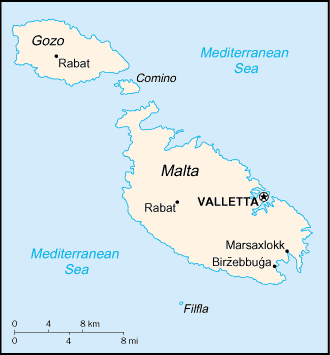Malta
Related Categories:
 Flag of Malta
Flag of MaltaTwo equal vertical bands of white (hoist side) and red; in the upper hoist-side corner is a representation of the George Cross, edged in red. |
 Symbols of Malta
Symbols of MaltaNational Flag, Emblem, Presidential Flag, Merchant Flag, and other flags and pennants.
www.doi.gov.mt/
Description of Flag, History, Flag Variants, Courtesy Flag, The George Cross, Specifications and Construction Sheet, Ensigns and Jack, Rank Flags and Pennants, Malta Police, Archbishop's Flag, Subnational Flags, Coat-of-Arms, Historical Flags.
www.fotw.us/
The islands constituting the Maltese nation have been ruled by various powers and fought over for centuries, most recently the United Kingdom.
en.wikipedia.org/
Malta was an important cultic center for earth-mother worship in the 4th millennium B.C. Archeological work shows a developed religious center there long before those of Sumer and Egypt. Malta's written history began well before the Christian era. The Phoenicians, and later the Carthaginians, established ports and trading settlements on the island. During the second Punic War (218 B.C.), Malta became part of the Roman Empire. During Roman rule, in A.D. 60, Saint Paul was shipwrecked on Malta at a place now called St. Paul's Bay.
In 533 A.D. Malta became part of the Byzantine Empire and in 870 came under Arab control. Arab occupation and rule left a strong imprint on Maltese life, customs, and language. The Arabs were driven out in 1090 by a band of Norman adventurers under Count Roger of Normandy, who had established a kingdom in southern Italy and Sicily. Malta thus became an appendage of Sicily for 440 years. During this period, Malta was sold and resold to various feudal lords and barons and was dominated successively by the rulers of Swabia, Aquitaine, Aragon, Castile, and Spain.
In 1522 Suleiman II drove the Knights of St. John out of Rhodes. They dispersed to their commanderies in Europe and after repeated requests for territory to Charles V, in 1530 the Knights were given sovereignty of Malta under the suzerainty of the Kings of Sicily. In 1523, a key date in Maltese history, the islands were ceded by Charles V of Spain to the Order of the Knights of St. John of Jerusalem. For the next 275 years, these famous "Knights of Malta" made the island their domain. They built towns, palaces, churches, gardens, and fortifications and embellished the island with numerous works of art and enhanced cultural heritage. In 1565 Suleiman the Magnificent laid siege to Malta. After several months the strength of the Knights and the Maltese population prevailed and the Turks were defeated. Over the years, the power of the Knights declined, however, and their rule of Malta ended with their peaceful surrender to Napoleon in 1798.
The people of Malta rose against French rule, which lasted two years, and with the help of the British evicted them in 1800. In 1814, Malta voluntarily became part of the British Empire. Under the United Kingdom, the island became a military and naval fortress, the headquarters of the British Mediterranean fleet. During World War II, Malta survived relentless raids from German and Italian military forces (1940-43). In recognition, King George VI in 1942 awarded the George Cross "to the island fortress of Malta--its people and defenders." President Franklin Roosevelt, describing the wartime period, called Malta "one tiny bright flame in the darkness." In September 1943, the Italian fleetís surrender in Malta was signed by U.S. General Dwight Eisenhower and Italian Marshal Pietro Badoglio. Victory Day, celebrated on September 8, commemorates victory in the 1565 Great Siege, and the end of the WWII attacks in Malta. Malta obtained independence on September 21, 1964, became a Republic on December 13, 1974, and a member of the European Union on May 1, 2004. The last British forces left in March 1979.
www.state.gov/r/
Introduction
About
Contact
Symbols in The News
Interpret this Symbol
AAC
African
AI
Alchemy
Alphabets
Ancient
Animal Symbolism
Architecture
Art
Articles
Astrology
Baha'i
Blissymbolics
Blueprint Symbols
Buddhist
Celtic Symbols
Cemetery
Chinese Symbols
Christian
Circle
City
Codes
Color
Conlangs
Crop Circles
Danger
Da Vinci Code
Designing Logos
Dictionaries
Dreams
Education
Egyptian Symbols
Electrical
Emoticons
Find Images
Fonts
Food
Fraternity
Hamsa
Healing
Heraldry
Hermetic
Highway Signs
Hindu
History
Hobo
Holiday
Icons
iConji
Islamic
Jain Symbols
Japanese, Kanji
Jewish
Justice
Law
Literary Symbolism
Mandalas
Map
Masonic
Math, Number
Meaning of Names
Medical
Middle East
Military
Miscellaneous
Money
Music
Mythology
Native American
Playing Cards
Power
Psychology
QiQiiKhu
Reiki
Religious
Runes, Norse
Sacred Geometry
Scientific
Science Fiction
Sorority
Sports
Symbols in the News
Tattoos
ThirteenSymbols
Tree of Life
Ursprache
Videos
Visual Languages
Weather
Web Codes
Wicca
Words
Writing Systems
Braille
Coinherence
Coptic
Cuneiform
Easter Island
Etruscan
Happy Human
Hebrew
Kokopelli
Linear B
Lotus
Love Symbols
Mandorla
Moon Alphabet
Nine Pointed Star
Om
Oz
Phonetic
Scarab Beetle
Silent
Theosophy
Unifon
About
Contact
Symbols in The News
Interpret this Symbol
AAC
African
AI
Alchemy
Alphabets
Ancient
Animal Symbolism
Architecture
Art
Articles
Astrology
Baha'i
Blissymbolics
Blueprint Symbols
Buddhist
Celtic Symbols
Cemetery
Chinese Symbols
Christian
Circle
City
Codes
Color
Conlangs
Crop Circles
Danger
Da Vinci Code
Designing Logos
Dictionaries
Dreams
Education
Egyptian Symbols
Electrical
Emoticons
Find Images
Fonts
Food
Fraternity
Hamsa
Healing
Heraldry
Hermetic
Highway Signs
Hindu
History
Hobo
Holiday
Icons
iConji
Islamic
Jain Symbols
Japanese, Kanji
Jewish
Justice
Law
Literary Symbolism
Mandalas
Map
Masonic
Math, Number
Meaning of Names
Medical
Middle East
Military
Miscellaneous
Money
Music
Mythology
Native American
Playing Cards
Power
Psychology
QiQiiKhu
Reiki
Religious
Runes, Norse
Sacred Geometry
Scientific
Science Fiction
Sorority
Sports
Symbols in the News
Tattoos
ThirteenSymbols
Tree of Life
Ursprache
Videos
Visual Languages
Weather
Web Codes
Wicca
Words
Writing Systems
Braille
Coinherence
Coptic
Cuneiform
Easter Island
Etruscan
Happy Human
Hebrew
Kokopelli
Linear B
Lotus
Love Symbols
Mandorla
Moon Alphabet
Nine Pointed Star
Om
Oz
Phonetic
Scarab Beetle
Silent
Theosophy
Unifon
